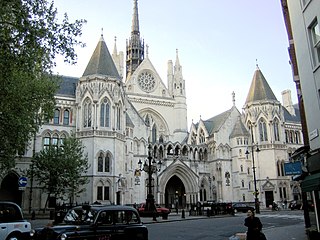
In law, a trust is a relationship in which the holder of property gives it to another person or entity who must keep and use it solely for the benefit of another person or group of persons. In the English common law tradition, the party who entrusts the property is known as the "settlor", the party to whom the property is entrusted is known as the "trustee", the party for whose benefit the property is entrusted is known as the "beneficiary", and the entrusted property itself is known as the "corpus" or "trust property". A testamentary trust is created by a will and arises after the death of the settlor. An inter vivos trust is created during the settlor's lifetime by a trust instrument. A trust may be revocable or irrevocable; an irrevocable trust can be "broken" (revoked) by a judicial proceeding or by consent of the settlor and the beneficiaries.

Trustee is a legal term which, in its broadest sense, is a synonym for anyone in a position of trust and so can refer to any individual who holds property, authority, or a position of trust or responsibility for the benefit of another. A trustee can also be a person who is allowed to do certain tasks but not able to gain income. Although in the strictest sense of the term a trustee is the holder of property on behalf of a beneficiary, the more expansive sense encompasses persons who serve, for example, on the board of trustees of an institution that operates for a charity, for the benefit of the general public, or a person in the local government.
Charitable contribution deductions for United States Federal Income Tax purposes are defined in section 170(c) of the Internal Revenue Code as contributions to or for the use of certain nonprofit enterprises.
A 529 plan, also called a Qualified Tuition Program, is a tax-advantaged investment vehicle in the United States designed to encourage saving for the future higher education expenses of a designated beneficiary. In 2017, K–12 public, private, and religious school tuition were included as qualified expenses for 529 plans along with post-secondary education costs after passage of the Tax Cuts and Jobs Act.

A charitable organization or charity is an organization whose primary objectives are philanthropy and social well-being.
A gift tax or known originally as inheritance tax is a tax imposed on the transfer of ownership of property during the giver's life. The United States Internal Revenue Service says that a gift is "Any transfer to an individual, either directly or indirectly, where full compensation is not received in return."
A 501(c) organization is a nonprofit organization in the federal law of the United States according to Internal Revenue Code and is one of over 29 types of nonprofit organizations exempt from some federal income taxes. Sections 503 through 505 set out the requirements for obtaining such exemptions. Many states refer to Section 501(c) for definitions of organizations exempt from state taxation as well. 501(c) organizations can receive unlimited contributions from individuals, corporations, and unions.
In the United States, a donor-advised fund is a charitable giving vehicle administered by a public charity created to manage charitable donations on behalf of organizations, families, or individuals. To participate in a donor-advised fund, a donating individual or organization opens an account in the fund and deposits cash, securities, or other financial instruments. They surrender ownership of anything they put in the fund, but retain advisory privileges over how their account is invested, and how it distributes money to charities.
Planned giving is an area of fundraising that refers to several specific gift types that can be funded with cash, equity, or property. These gift vehicles are commonly based on United States tax law, but Canada, the United Kingdom, and other nations are beginning to establish similar laws. In the United States the specific rules of planned giving are defined by the United States Congress and the Internal Revenue Service.
A charitable gift annuity is a gift vehicle that falls into the category of planned giving. It involves a contract between a donor and a charity, whereby the donor transfers assets, such as cash or securities, to the charity in exchange for a partial tax deduction and a lifetime stream of periodic income from the charity. When the donor dies, the charity keeps the remaining assets.
The U.S. generation-skipping transfer tax imposes a tax on both outright gifts and transfers in trust to or for the benefit of unrelated persons who are more than 37.5 years younger than the donor or to related persons more than one generation younger than the donor, such as grandchildren. These people are known as "skip persons". In most cases where a trust is involved, the GST tax will be imposed only if the transfer avoids incurring a gift or estate tax at each generation level.

An interest in possession trust is a trust in which at least one beneficiary has the right to receive the income generated by the trust or the right to enjoy the trust assets for the present time in another way. The beneficiary with the right to enjoy the trust property for the time being is said to have an interest in possession and is colloquially described as an income beneficiary, or the life tenant.

United States trust law is the body of law that regulates the legal instrument for holding wealth known as a trust.

A supporting organization, in the United States, is a public charity that operates under the U.S. Internal Revenue Code in 26 USCA 509(a)(3). A supporting organization either makes grants to, or performs the operations of, a public charity similar to a private foundation.
A charitable remainder unitrust is an irrevocable trust created under the authority of the United States Internal Revenue Code § 664 ("Code"). This special, irrevocable trust has two primary characteristics: (1) Once established, the CRUT distributes a fixed percentage of the value of its assets to a non-charitable beneficiary ; and (2) At the expiration of a specified time, the remaining balance of the CRUT's assets is distributed to charity. The trustee determines the fair market value of the CRUT's assets at the time of contribution and thereafter on the applicable valuation date. The fixed annuity percentage must be at least 5% and no more than 50% of the fair market value of the assets in the corpus. The remainder must be at least 10% of the fair market value of the assets contributed to the CRUT. Code Section 664(d)(1) sets the federal income tax requirements for a charitable remainder unitrust.

A private foundation is a tax-exempt organization that does not rely on broad public support and generally claims to serve humanitarian purposes.
In the United States, the estate tax is a federal tax on the transfer of the estate of a person who dies. The tax applies to property that is transferred by will or, if the person has no will, according to state laws of intestacy. Other transfers that are subject to the tax can include those made through a trust and the payment of certain life insurance benefits or financial accounts. The estate tax is part of the federal unified gift and estate tax in the United States. The other part of the system, the gift tax, applies to transfers of property during a person's life.

Charitable trusts in English law are a form of express trust dedicated to charitable goals. There are various advantages to charitable trust status, including exemption from most forms of tax and freedom for the trustees not found in other types of English trusts. To be a valid charitable trust, the organization must demonstrate both a charitable purpose and a public benefit. Applicable charitable purposes are normally divided into categories for public benefit, including the relief of poverty, the promotion of education, the advancement of health and saving of lives, the promotion of religion, and all other types of trusts recognized by the law. There is also a requirement that the trust's purposes benefit the public, and not simply a group of private individuals.

The cy-pres doctrine in English law is an element of trusts law that deals with charitable trusts. The doctrine states that when such a trust has failed because its purposes are either impossible or cannot be fulfilled, the High Court of Justice or the Charity Commission can issue an order redirecting the trust's funds to the nearest possible purpose. For charities worth under £5,000 and without land, the trustees may decide to redirect the trust's funds. The doctrine was initially part of ecclesiastical law, originating from the Norman French phrase cy près comme possible, but similar and possibly ancestral provisions have been found in Roman law, both in the Corpus Juris Civilis and later Byzantine law.
The Pooled Income Fund (PIF) is a type of charitable mutual fund or charitable trust that pools the securities or cash separately donated by an individual, a family or a corporation to a charity, which is then invested to provide dividends for both the donor's beneficiary and charity. The donations are irrevocable and tax-deductible and must be from personal assets. Capital gains taxes do not apply to securities donated to such a fund. The Pooled Income Fund was created by the Tax Reform Act of 1969 and is governed by IRS Section 642(c)(5).






